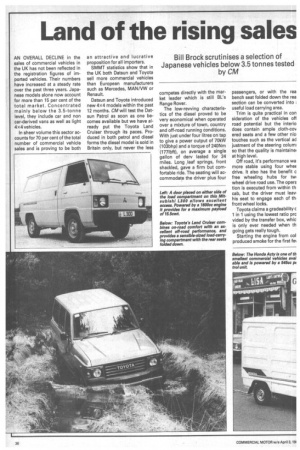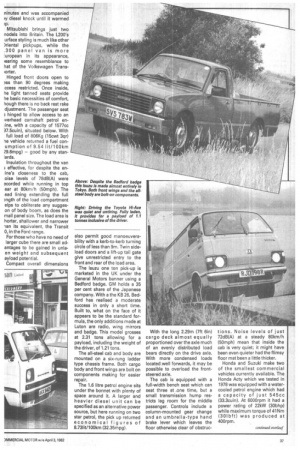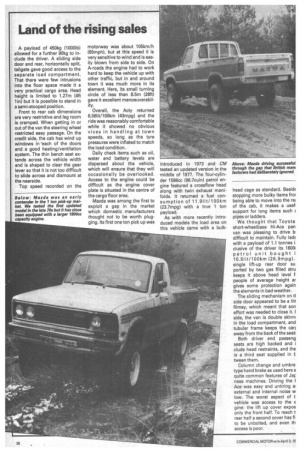Land of the rising sales
Page 30

Page 31

Page 32

If you've noticed an error in this article please click here to report it so we can fix it.
Bill Brock scrutinises a selection of Japanese vehicles below 3.5 tonnes tested by CM
AN OVERALL DECLINE in the sales of commercial vehicles in the UK has not been reflected in the registration figures of imported vehicles. Their numbers have increased at a steady rate over the past three years. Japanese models alone now account for more than 15 per cent of the total market. Concentrated mainly below the 3.5-tonne level, they include car and non car-derived vans as well as light 4x4 vehicles.
In sheer volume this sector accounts for 70 per cent of the total number of commercial vehicle sales and is proving to be both an attractive and lucrative proposition for all importers.
SMMT statistics show that in the UK both Datsun and Toyota sell more commercial vehicles than European manufacturers such as Mercedes, MAN/VW or Renault.
Datsun and Toyota introduced new 4x4 models within the past 12 months. CM will test the Datsun Patrol as soon as one becomes available but we have already put the Toyota Land Cruiser through its paces. Produced in both petrol and diesel forms the diesel model is sold in Britain only, but never the less competes directly with the market leader which is still BL's Range Rover.
The low-revving characteristics of the diesel proved to be very economical when operated over a mixture of town, country and off-road running conditions. With just under four litres on tap to give a power output of 70kW (103bhp) and a torque of 240Nm (177Ibft), on average a single gallon of dery lasted for 24 miles. Long ,leaf springs, front shackled, gave a firm but comfortable ride. The seating will accommodate the driver plus four passengers, or with the rea bench seat folded down the rea section can be converted into ; useful load carrying area.
Trim is quite practical in con sideration of the vehicles off road potential but the interio does contain ample cloth-coy ered seats and a few other nicl touches such as the vertical ad justment of the steering columi so that the quality is maintaine4 at high level.
Off road, it's performance wa more stable using four whe€ drive. It also has the benefit c free wheeling hubs for twi wheel drive road use. The opera tion is executed from within th cab, but the driver must leavi his seat to engage each of th, front wheel locks.
Toyota claims a gradeability c 1 in 1 using the lowest ratio prc vided by the transfer box, whic is only ever needed when th going gets really tough.
Starting the engine from col produced smoke for the first fel ninutes and was accompanied oy diesel knock until it warmed ip.
Mitsubishi brings just two nodels into Britain. The L200's urface styling is much like other )riental pickpups, while the .300 panel van is more iuropean in its appearance, leering some resemblance to hat of the Volkswagen Transloner.
Hinged front doors open to Dss than 90 degrees making ccess restricted. Once inside, he light tanned seats provide he basic necessities of comfort, hough there is no back rest rake djustment. The passenger seat ; hinged to allow access to an iverhead camshaft petrol enline, with a capacity of 1577cc 37.5cuin), situated below. With full load of 806Kg (15cwt 3qr) le vehicle returned a fuel conumption of 9.54 lit/100km 29.6mpg) — good by any sten Insulation throughout the van ; effective, for despite the enine's closeness to the cab, oise levels of 78dB(A) were ecorded while running in top ear at 80km/h (50mph). The ead lining extending the full ?.ngth of the load compartment elps to obliterate any suggeson of body boom, as does the mall panel size. The load area is horter, shallower and narrower -Ian its equivalent, the Transit 0, in the Ford range.
For those who have no need of larger cube there are small adantages to be gained in unlaen weight and subsequent ayload potential.
Compact overall dimensions also permit good manoeuverability with a kerb-to-kerb turning circle of less than 9m. Twin sideload doors and a lift-up tail gate give unrestricted entry to the front and rear of the load area.
The lsuzu one ton pick-up is marketed in the UK under the General Motors banner using a Bedford badge. GM holds a 35 per cent share of the Japanese company. With a the KB 26, Bedford has realised a moderate success in only a short time. Built to, what on the face of it appears to be the standard formula, the only additions made at Luton are radio, wing mirrors and badge. This model grosses at 2.31 tons allowing for a payload, including the weight of the driver, of 1.21 tons.
The all-steel cab and body are mounted on a six-rung ladder type chassis frame. Both cargo body and front wings are bolt on components making for easier repair.
The 1.6 litre petrol engine sits under the bonnet with plenty of space around it. A larger and heavier diesel unit can be specified as an alternative power source, but here running on two star petrol, the pick up returned economical figures of 8.731it/100km (32.35mpg). With the long 2.29m (7ft 6in) cargo deck almost equally proportioned over the axle much of an evenly distributed load bears directly on the drive axle. With more condensed loads located well forwards, it may be possible to overload the frontsteered axle.
The cab is equipped with a full-width bench seat which can seat three at one time, but a small transmission hump restricts leg room for the middle passenger. Controls include a column-mounted gear change and an umbrella-type hand brake lever which leaves the floor otherwise clear of obstruc
tions. Noise levels of just 72dB(A) at a steady 80km/h (50mph) mean that inside the cab is very quiet; it might have been even quieter had the flimsy floor mat been a little thicker.
Honda and Suzuki make two of the smallest commercial vehicles currently available. The Honda Acty which we tested in 1978 was equipped with a watercooled petrol engine which had a capacity of just 545cc (33.3cuin). At 6000rpm it had a power rating of 22kW (30bhp) while maximum torque of 41Nm (301bft) was produced at 40Orpm. A payload of 450kg (1000Ib) allowed for a further 90kg to include the driver. A sliding side door and rear, horizontally split, tailgate gave good access to the separate load compartment. That there were few intrusions into the floor space made it a very practical cargo area. Head height is limited to 1.27m (4ft fin) but it is possible to stand in a semi-stooped position.
Front to rear cab dimensions are very restrictive and leg room is cramped. When getting in or out of the van the steering wheel restricted easy passage. On the credit side, the cab has wind up windows in 'each of the doors and a good heating/ventilation system. The thin bench seat extends across the vehicle width and is shaped to clear the gear lever so that it is not too difficult to slide across and dismount at the nearside.
Top speed recorded on the motorway was about 105km/h (65mph), but at this speed it is very sensitive to wind and is easily blown from side to side. On A-roads the engine had to work hard to keep the vehicle up with other traffic, but in and around town it was much more in its element. Here, its small turning circle of less than 8.5m (28ft) gave it excellent manoeuverability.
Overall, the Acty returned 6.561it/100km (43mpg) and the ride was reasonably comfortable while it showed no obvious vices in handling at town speeds, so long as the tyre pressures were inflated to match the load condition.
Daily check items such as oil, water and battery levels are dispersed about the vehicle, which will ensure that they will occasionally be overlooked. Access to the engine could be difficult as the engine cover plate is situated in the centre of the cargo floor area.
Mazda was among the first to exploit a gap in the market which domestic manufacturers thought not to be worth plugging. Its first one ton pick up was introduced in 1973 and CM tested an updated version in the middle of 1977. The four-cylinder 1586cc (96.7cuin) petrol engine featured a crossflow head along with twin exhaust manifolds. It returned a fuel consumption of 1 1.91it/1 00km (23.7mpg) with a true 1 ton payload.
As with more recently introduced models the load area on this vehicle came with a bulk head cage as standard. BesidE stopping more bulky items froi being able to move into the rei of the cab, it makes a use support for long items such pipes or ladders.
We thought that Toyota short-wheelbase Hi-Ace pan van was pleasing to drive la difficult to maintain. Fully ladE with a payload of 1.1 tonnes i clusive of the driver its 16001 petrol unit bought i 10.51it/100km (26.9mpg).
single lift-up rear door su ported by two gas filled stru keeps it above head level f people of average height ar gives some protection again the elements in bad weather.
The sliding mechanism on tl side door appeared to be a litt flimsy, which meant that son effort was needed to close it. I side, the van is double skinni in the load compartment, and tubular frame keeps the caq away from the back of the seat: Both driver and passeng seats are high backed and i clude head restraints, and the is a third seat supplied in t tween them.
Column change and umbre type hand brake as used here a
quite common features of Jar nese machines. Driving the I Ace was easy and untiring al external and internal noise w low. The worst aspect of t vehicle was access to the E gine: the lift up cover expos only the front half. To reach t rear half a second cover has fi to be unbolted, and even th access is poor.


















































